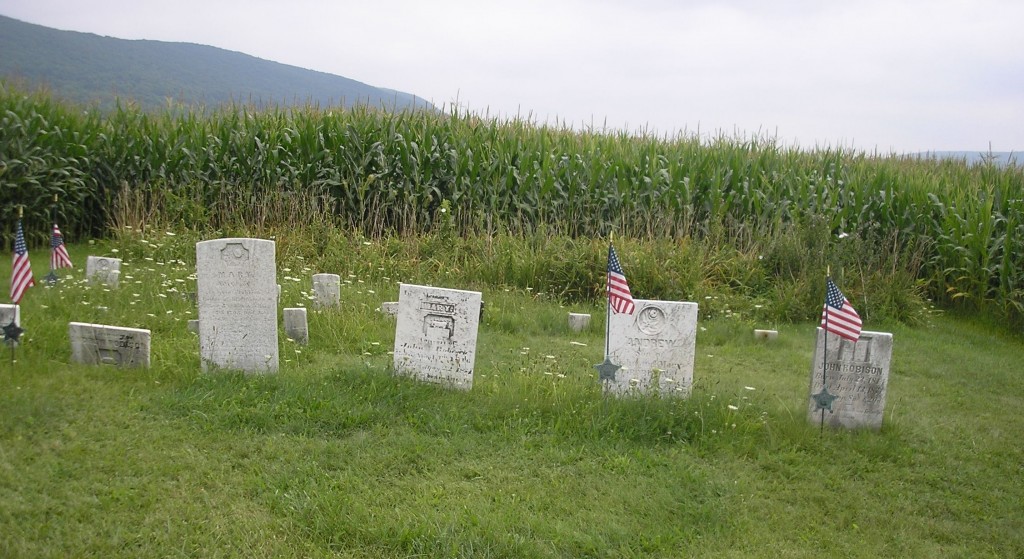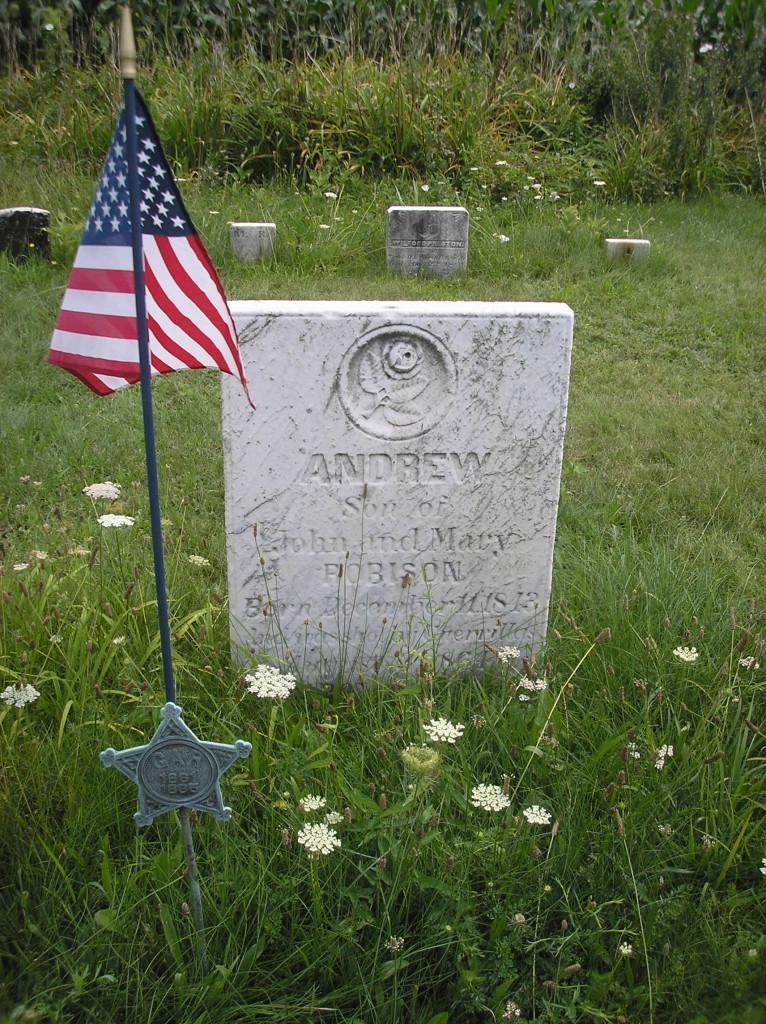Boyer Cemetery in Washington Township
Posted By Norman Gasbarro on December 5, 2010
Along many of the lesser-traveled roads and bi-ways of the Lykens Valley are a fair number of small cemeteries. These cemeteries once were family burial plots on family land or were grave yards aside churches that have long ceased to exist. They are not marked by signs, or are not easily accessible. Previously mentioned was the Hoffman Monument to John Peter Hoffman that is in the middle of a cornfield along the Crossroads. It marks the spot where Hoffman and twenty-six of his contemporaries are buried. A small cemetery, just off Route 209 (west of Loyalton) on Rakers Mill Road, with about two dozen or so marked graves is both easy to locate and generally maintained. The graves of several Civil War veterans are clearly recognized.
On an 1875 map of Washington Township, Dauphin County, both a church and school are shown. They appear to be on or around land owned by G. A. Boyer. The current President of the Gratz Historical Society, Catherine Kieffer, referred to the cemetery as the Boyer cemetery, the name that it is still known by among the locals. The church and school don’t exist anymore, but the cemetery can be easily seen from the road and the cornfield around it has been respectfully stopped around the graves to allow clear access. The Civil War graves are recognized by the G.A.R. star and flags, a sign that an area veteran’s group knows about the cemetery and has taken the responsibility for recognizing the patriotic deeds of those interred there.
One of the most interesting graves in this cemetery is that of Andrew Robison (1843-1864).
Andrew was born in or around the Wiconisco Township area of Dauphin County, Pennsylvania on 11 December 1843, the son of John and Mary Robison. John was a Forge Man. In 1850, Andrew, age 6, and his younger siblings, Mary, John and Martha Jane, were living in Wiconisco Township in an area surrounded by others of the same trade. By 1860, Andrew’s occupation was Helper, no doubt to his father or to one of the many Forge Men or Blacksmiths in the area. At this point, the mother Mary is no longer named in the census. We learn from a stone in the Boyer cemetery that Andrew’s mother, named as “consort” on her grave marker, had died in the early 1850s (the date on the stone is difficult to ready) Two additional siblings of Andrew appear in the 1860 census: Rachael, age 8, and Peter, age 6. Andrew’s father John may have also remarried to a woman named Phebe. [The younger two children could be the children of Phebe or the children of Mary, depending on the death date of Mary].
On 19 Sep 1861, at Berrysburg, Dauphin County, Andrew enrolled in the 9th Pennsylvania Cavalry, Company B. He gave his age as 20, although other records show he was probably only 17, a few months shy of his 18th birthday. His muster records indicate that he was 5 foot 6 inches in height, had light colored complexion and hair, and gray eyes, His occupation was given as “Forger.” Andrew reported to camp on 7 October 1861 along with others from the Lykens Valley area.
Whether his choice of regiment was due to his occupation – forgers and blacksmiths were needed in the cavalry – or due to friendship with others from the area is not known. What is known is that training was difficult, especially without horses or weapons. The procurement of horses and equipment was going more slowly than the enlistment of the men. A diarist of the 9th Pennsylvania Cavalry noted that Andrew was disciplined for fighting with a man named Hoover. Both were required to stand on a board on a half-barrel for a few hours but they continued to fight while on the board. After the training period the 9th Pennsylvania Cavalry went off to war
We don’t know much specific about Andrew during the remainder of the time he served in the regiment. Following the map route that this regiment took, it can be assumed that Andrew, with the 9th Pennsylvania Cavalry, crossed Pennsylvania into Ohio and then Indiana and then headed south into Kentucky where fighting would take place.
Following the regiment as a constant threat to its safety were loosely organized groups of Confederate guerillas, or bushwhackers. These rebel bands fired shots into the camp of the 9th Cavalry and ambushed them along the roads. The difficulties faced by the regiment because of these guerillas are recounted by the diarist and are reported in histories of the 9th Cavalry. It was Pvt. Andrew Robison’s misfortune that these rebels were still a threat into August of 1864. The diarist wrote:
George Burkle came into camp this morning. He was taken prisoner near Taylorsville on Our Last Scout by Guerillas. They took His Horse and arms and parolled him. He saved his money By throwing it away and after Being paroled found it again After the Guerillas Left him. He Had to Walk to Louisville.
Andrew Robison of our company was Brought Dead into the City to day. He was along with the Scout. It is supposed That He was shot by Guerrillas on His road Back to the City with a Dispatch. He was Shot through the Heart and Drawed up to a tree 7 miles from the city on the Salt river pike.
Andrew’s date of death is given as 4 August 1864 and the place of death as Louisville, Kentucky. Fortunately for Andrew’s family, his body was recovered and returned to the Lykens Valley. For many other families, the dead were never identified or given a burial in a marked grave. On the stone marker for Andrew Robison are the words: “And was shot by Guerillas August 4, 1864.”
Note: Some of the information for the above post was taken from John W. Rowell’s Yankee Cavalrymen: Through the Civil War with the Ninth Pennsylvania Cavalry. The diarist who is mentioned, and through whose words most of the stories in the book are told, is Corp. William Thomas of Lykens, Dauphin County, Pennsylvania, who served in the same Company B as Andrew Robison.
 ;
;




I enjoy your website with the historical info of the Lykens Valley, the Railroad, the Millerburg Ferry and the Cemeteries.
I especially like the photo of the young family waiting at the train station at Loyalton.
I was raised in a house of log construction along the Railroad road approximately 1/4 mile east of Bickels crossing. I remember when the engineer of the train stopped at our house to pick up some items after we butchered some pigs.
Marvin Laudenslager
Daleville, VA 24083
Thank you for this post.